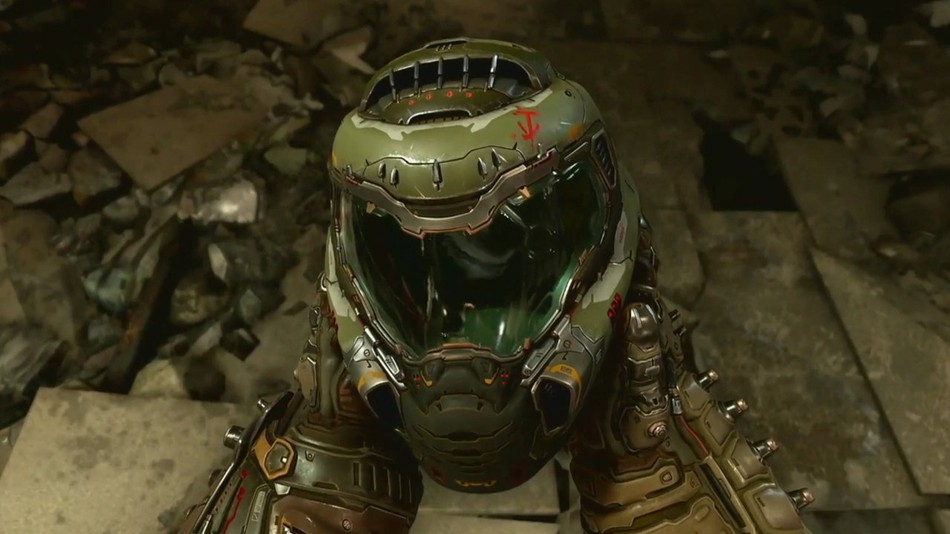
An Immersive, Interactive experience brings with it the opportunity for Players to make their own decisions, choose their own paths, play with the freedom they want – but is it problematic when the player is thrust into playing an Angry Protagonist?
The above video is from the gameplay showcase of DOOM Eternal, developed by id Software,. DOOM Eternal is the sequel to 2016’s widely popular DOOM, itself a reboot of the classic 1993 game of the same name, by id Software under industry stars John Carmack and John Romero.
Depicted in the trailer above are NPCs cowering in fear as the protagonist, the Doomslayer passes by. The Doomslayer then chokes an NPC, pulling them by the lanyard around their neck to a card reader. This guy is angry. Is it healthy to portray a protagonist like this?
When DOOM came out in the 90’s, there were few avenues for expressing emotion in a video game. DOOM was leaps and bounds ahead of its contemporaries, leading to the rise of “Doom Clones”, which can be traced through to today with releases like Overwatch and Call of Duty, but back then the only ways to create immersive tension were through sound design, on-screen queues, and through the bad guys you fought.
If you’re interested in the history of DOOM, YouTuber Ahoy produced a brilliant video history of the classic title.
Skip to today, the protagonist of DOOM, the “Doomslayer” (renamed from “Doomguy” in the classic 90’s titles), is portrayed as an angry, pissed-off Bad Ass, faceless and inscrutable, a far cry from the depiction of the classic Doomguy head in the screen’s lower centre. My concern is that this portrayed anger has become a selling point for DOOM as it goes through to release its next title.
I worry that video games have an anger issue.
Why? It’s Harmless fun!
Plenty of games depict anger through their playable characters., I’m using DOOM in this article merely as an best example. Team Fortress II, Mad Max (2015) and Assassin’s Creed II are reasonable examples, but these games portray so much more emotion than just anger.
Earlier this year, the World Health Organisation deemed Gaming Disorder as a serious concern. WHO acknowledges that the disorder is most noticeable through behavioural issues, and “Impairment” with social functions. To me, that sounds like it could segue straight into “causing anger issues.”
Immersing a player in a game is sure to leave lasting effects on them, especially if they consider themselves “Hardcore” or even a “Gamer” for that matter. If you’re willing to identify with traits and aspects reflected within video games, then can you contest the notion that anger can be induced through in-game representation?
It makes all the Difference that it’s interactive
In DOOM, you kill, you “rip and tear until it is done”, and you make your way through the Mars facility. There’s so little opportunity for the slayer to do anything beyond being pissed off as he, sometimes with his bare hands, rips demons limb from limb.
The 2016 title starts you in a peculiar situation – chained naked on a slab in a room surrounded by humanoid demons; you smash one of the demons heads against the table, and go for a gun, after busting out of the chains with your veiny wrists.
Sure, I reckon anybody would be pissed off if they started their day like this, but the Slayer carries this grudge the way through, there’s no end to the anger. They smash things that Samuel Hayden, the voice-over in the game, says not to, and when you receive weapon upgrades, you punch the robot who delivered them to you. So, i’ll pitch to you – is the anger of DOOM a selling point? And if that has some appeal, is it problematic?
I’m not going to disregard that TV shows and movies portray anger in stylistic and unique ways, and as impressive and stylistic as that can be, they lack the selling point of video games – the immersion – the gameplay.
The difference between depicting anger through a performance and anger in an immersive, interactive experience, is that in performances, the anger usually has a resolution. Either the character stops being angry, resolving their feelings in a positive way , or they’re forced to stop being angry by circumstance. In entertainment, anger is rarely framed as a positive trait.
I’m also not going to shy away from the fact that id is big on anger-inducing topics, as explored by Ahoy in the earlier referenced video. Nazi’s and Hell don’t exactly reek positivity, but at least the recent Wolfenstein games depict B.J Blazkowicz humanly, hating Nazi’s and holding on to what he loves – although, id only worked on the original Wolfenstein titles in the early 90’s, Machinegames have taken over since.
Silver Lining for the Angriest Man Alive?
We’re getting better with representation in video games. Things like character selection and creation allow players to create characters they identify with.
But the Doomslayer is angry, it’s the only emotion they exert, beyond the occasional secret finding animation. There isn’t even any choice to customise what you exert – customisation in DOOM is limited to weapon and suit upgrades, barely anything on a level of representation.
Maybe DOOM needs a silver lining in it. The aforementioned list of games involving anger would have included the God of War series, although the release this year brought us the silver lining – a narrative driven reflection on the Angriest God of the Pantheon, similar in release to a cinematic experience like last year’s Logan, a reflection on the life of Marvel character Wolverine.
I worry that, with gaming disorder considered, anger is being used as a selling point for DOOM, and that we might see this continued.
Maybe the Doomslayer needs his rabbit back, just to get some perspective on the lighter things in life.
